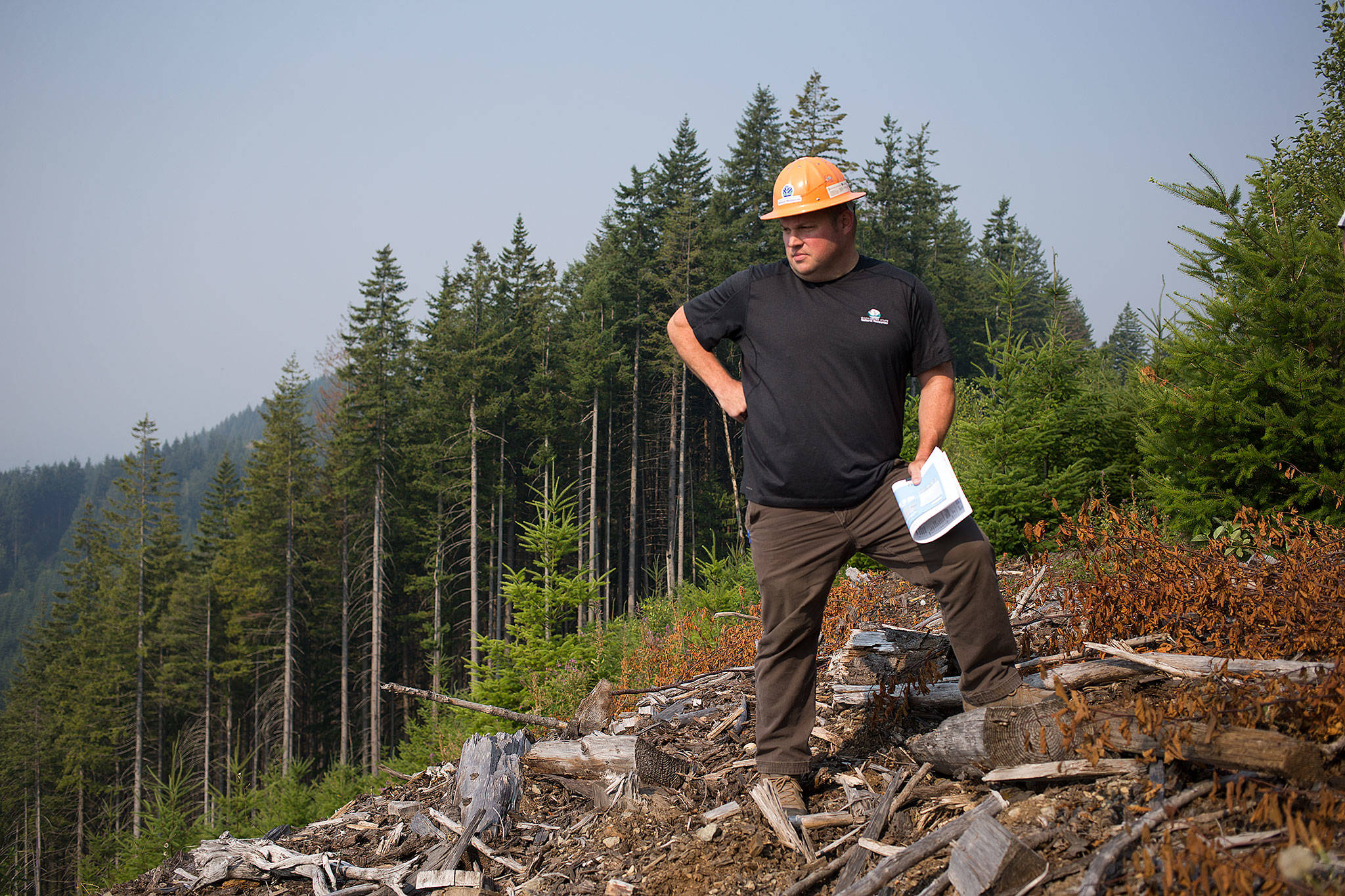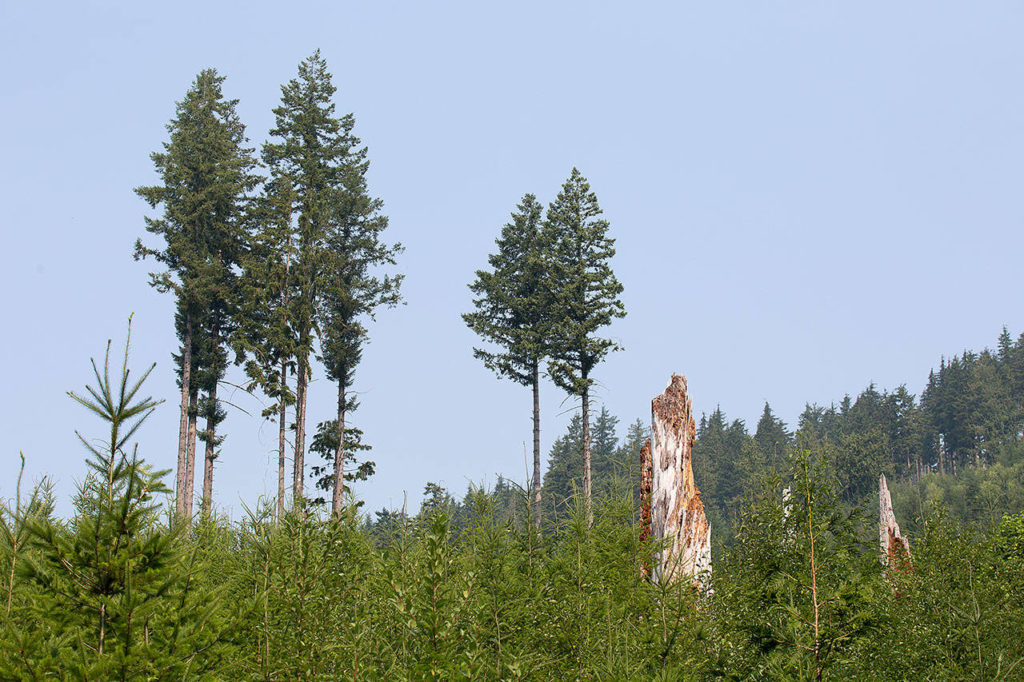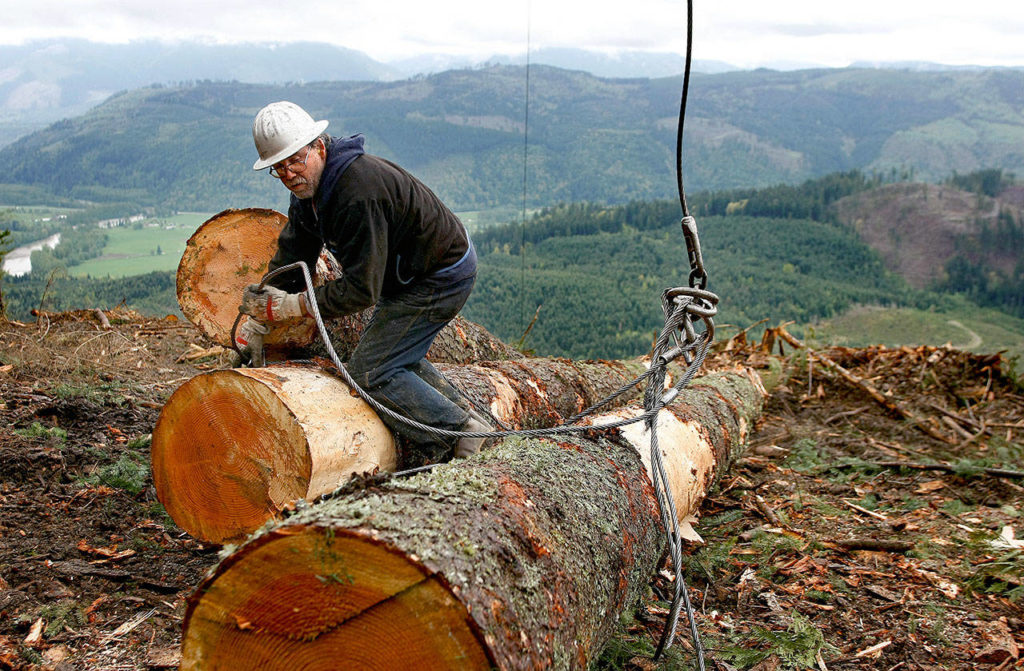ARLINGTON — A hillside overlooking the Stillaguamish Valley sprouts with young Douglas firs and western red cedar, eight years after being logged.
Much of the forest on Stimson Hill was cut down in 2009 following a state Department of Natural Resources timber auction. The next year, crews replanted the area. The trees growing there now, state officials say, show how it’s possible to raise money from logging, while safeguarding habitat and opportunities for outdoor recreation.
“We can’t do things today that are going to cause problems for the future,” said Mark Arneson, a DNR district manager. “We can’t do short-sighted management. We spend a lot of money and time trying to do the right thing out here.”
In ever-more-populous Snohomish County, plans to cut down public and private forests have put renewed scrutiny on logging. State forestry officials say they’re doing their best to balance competing interests. While environmentalists seldom object to cuts like the one on Stimson Hill, they have big ongoing concerns in the Skykomish Valley.
The best-known case is the Singletary harvest. In August, a judge voided a timber sale on land next to Wallace Falls State Park. DNR will have to conduct more environmental studies, unless it opts to appeal. The window to get any work done there this year has all but slipped away.
Separately, a nonprofit group is racing the clock to attract donations to buy a privately owned forest to shield popular hiking trails to Lake Serene and Bridal Veil Falls from a planned timber cut.
Forests and money
When it comes to managing forests, the DNR has a triple mandate: to raise money for local and state governments; to protect habitat; and to provide outdoor spaces for people to enjoy.
The agency oversees about 64,000 acres of trust land and state forest in Snohomish County. Logging on those lands brought in nearly $5.7 million last year to government coffers. The agency expects slightly more this year. The annual total has reached as high as $13.7 million, in 2004.
The money gets parceled out to state education funds, county government and other local jurisdictions. The DNR keeps a 25 percent management fee.
The trust lands are a legacy of the late 19th and early 20th centuries, when Washington’s forests were mowed down en masse. That left hundreds of thousands of acres of stumps. Depleted of its timber, the land often fell into foreclosure. Counties were left with the responsibility.
The Legislature devised a system for the state to manage the land for the counties. Permanent trusts would divvy the up money from the timber sales to pay for local services.
Snohomish and other counties started to turn over the land in the 1930s. The state replanted trees and took on firefighting duties. By the 1960s, logging had started to resume.
In late 2007, 76 acres on Stimson Hill sold for $1.5 million. Most of the trees there were about 85 years old.
Crews replanted the land in 2010, and again in 2011 to make up for frost-damaged nursery stock. They put in 400 trees per acre, a mixture of 75 percent Douglas fir and 25 percent western red cedar.
Crews applied herbicide last year to knock out big leaf maple trees that were crowding out the planted confers. Some trees could get logged by hand in the near future to thin out the forest.
“We’re investing now to pay off dividends for future generations,” Arneson said.
Logs are fetching higher prices than eight years ago. Douglas fir logs were commanding $579 per 1,000 board feet earlier this year, compared to $337 in 2009.
Singletary
The DNR harvests generally attract little controversy.
Then there’s the Singletary sale. Debated for a decade, the timber harvest near Gold Bar finally sold at auction in May.
The DNR had delayed a sale in 2014 to study concerns from conservationists. A major worry was protecting scenery around Wallace Falls State Park, which borders the proposed cut. Logging there also could compromise a property that Snohomish County is developing into an alternative trailhead for Wallace Falls to help take pressure off the main parking lot, which is often overflowing.
The state calls the logging operations “timber harvests.” Inessa Pearce, president of the Skykomish Valley Environmental & Economic Alliance, or SVENA for short, doesn’t agree with that terminology.
“We don’t call it harvesting — we call it cutting,” Pearce said.
Her group has been bird-dogging the Singletary cut. It’s also concerned about issues such as aerial pesticide spraying and the negative effect they believe logging would have on tourism along the U.S. 2 corridor.
Logging, Pearce and her allies note, now is a relatively small part of the local economy. The state Employment Security Department said that 104 people were employed in forestry or logging in Snohomish County last year, not including mills. By contrast, there were nearly 26,000 people working in the leisure or hospitality industries, though the forestry and logging jobs paid about twice as much on average.
Through a series of negotiations earlier this year, Snohomish County worked out an agreement with the DNR to reduce the size of the harvest to 166 acres from 187. That would result in less revenue. The land taken out of the harvest area is being transferred back to county control.
In May, the Pilchuck Audubon Society, Friends of the Wild Sky and the Skykomish Valley Environmental & Economic Alliance sued to stop the smaller sale, but the DNR went ahead anyway. The legal arguments against the auction included that it wasn’t just smaller, but fundamentally different because of factors such as logging trucks running through county parkland. They also objected to the state counting trees in the protected area toward the ones that needed to be left uncut during the harvest.
Sierra Pacific Industries of Anderson, California, put in the winning bid of $1.7 million. That gave the company the right to log the land within three years. It planned to send the timber to its mill in Burlington.
In June, the DNR estimated that the state schools budget would have netted nearly $800,000 from the sale. The county would have gotten $193,000 for roads and another $114,000 for general operations. The local fire district, Sno-Isle Libraries, the hospital in Monroe and Sultan schools each were in line for smaller portions.
Joe Beavers, a former Gold Bar mayor, made several trips to the County Council, urging elected officials to help the DNR defend itself against the environmental groups so that the local governments could get their money.
In Beavers’ characterization, the environmental groups supported the compromise only to turn around “and invent a lawsuit to stop the complete sale.”
“So, school kids, first responders, hospital patients, and library patrons in the Sky Valley lose out so that the Pilchuck Audubon members don’t have to look at tree stumps when they walk in the woods,” he told the council in July.
A month later, a Snohomish County Superior Court judge sided with the environmental groups. Judge Millie Judge canceled the Singletary sale. Judge ordered the DNR to re-examine the impacts from logging, in light of transferring 21 acres to the county.
Peter Goldman, an attorney with the Seattle-based Washington Forest Law Center, said the plaintiffs’ position has been mischaracterized.
“We’re giving DNR options — we’re not saying we won Singletary, abandon it, we’re done,” he said.
Goldman wants the DNR to take what he considers a more balanced approach than the traditional “industrial use of a forest.”
State timber cuts typically leave eight trees standing per acre, plus buffers around critical habitat. Goldman called that “just one step above a compete clear cut. Not much better.” A consultant is working on an alternative forestry plan that Goldman hopes to present to the DNR soon.
“There’s a different way of looking at this,” he said. “Let’s take a shot at it.”
Logging Singletary would require building roads and bridges. That infrastructure would provide access for future logging of another 1,500 acres of trust land. Those harvests would border the state park, which measures about 4,700 acres.
Moreover, the timber trust land is part of the DNR’s Reiter Forest, which also includes the Reiter Foothills recreation area. Wallace Falls State Park draws about 175,000 visitors each year. Also in the vicinity: the state’s Morning Star Natural Resources Conservation area and the federally managed Wild Sky Wilderness Area.
Bridal Veil Falls and Lake Serene
The Singletary sale isn’t the only proposed timber cut in the Skykomish Valley that’s got hikers worried.
Weyerhaeuser is planning this winter to log part of its privately owned property that crosses over popular hiking trails to Lake Serene and Bridal Veil Falls.
Hiking advocates are working to pare a U.S. Forest Service plan to close the trail for 10 months, starting as early as Tuesday. A conservation group, meanwhile, is trying to raise enough money to buy the property from Weyerhaeuser.
The Forest Service closure is intended to keep the area safe during logging operations. The Forest Service intends to use the down time to make upgrades to the trail. Under the current plan, the trail would reopen July 1.
“If the timber harvest is completed before July, the Forest Service will lift the closure once it is safe to do so,” said Tracy O’Toole, a spokeswoman for the agency.
The Washington Trails Association is trying to convince the Forest Service to shorten the closure to Oct. 2 through March 31 to avoid peak hiking season. The group also hopes to keep trails open on weekends.
The Lake Serene Trail is one of Washington’s most popular day hikes, attracting more than 45,000 people each year.
Forterra, a Seattle-based nonprofit, has been working with Weyerhaeuser to arrange a potential sale of the property.
“We have worked with Forterra in the past on similar transactions and enjoy a strong relationship with their organization,” company spokesman Anthony Chavez said.
If the sale goes through, Weyerhaeuser would log 50 to 100 acres of that land, Chavez said. The amount depends on what the DNR approves. There are no plans to cut down trees in the immediate area of the lake or falls.
Forterra recently launched a campaign to raise $275,000 by Oct. 30 to save the trail.
The purchase would cost just over $800,000. Roughly half of that could be covered by Snohomish County’s Conservation Futures program. Other sources should bring the total to about $525,000.
Forterra, formerly known as the Cascade Land Conservancy, would take ownership of the land some time next year.
“Before we walked to them, they were planning on logging pretty much the whole property,” said Charlie Raines, the nonprofit’s director of forest conservation.
The plan would keep intact forest along more than 500 feet of the trail where the logging would have been most noticeable.
The Lake Serene Trail is part of Forterra’s wider campaign called the Great Northern Corridor. The conservation efforts focus on the U.S. 2 corridor between the upper Skykomish Valley and Puget Sound. After the Lake Serene property, the nonprofit hopes to buy two others from Weyerhaeuser: Maloney Creek, near the town of Skykomish, and Windy Ridge, near Stevens Pass.
Noah Haglund: 425-339-3465; nhaglund@heraldnet.com. Twitter: @NWhaglund.
Talk to us
> Give us your news tips.
> Send us a letter to the editor.
> More Herald contact information.




























